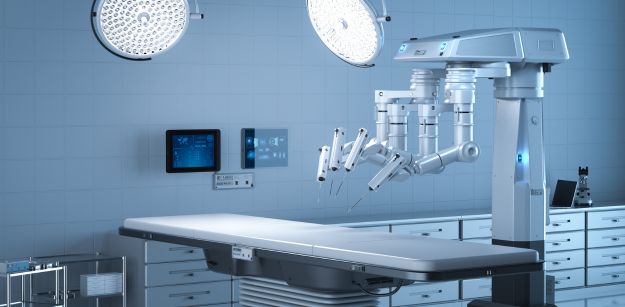We are all aware of the fact that healthcare has totally transformed itself from its traditional ways of treatments and practices. Latest advancements in the technological field have affected the healthcare system immensely which has led to innovation in personalized medicines and technology-enabled care.

Keeping in view the latest technological advancements in the healthcare system at large we see prominent progression in the field of robotic surgery. It has surely made the treatment procedure safer, cheaper, and more accessible in developing nations.
The application of robotic surgery became more common after the first trans-Atlantic remote surgery in 2001.
The reason behind its vast application is due to the many benefits it offers over the traditional methods of surgery. It requires the least incision which is beneficial for both patient and the surgeon. At the same time, new and advanced robotic platforms and tools are further improving the general procedure of surgery making it even safer and more reliable.
Robotic surgery: what is it?
A surgical robot is an autonomous, computer-controlled tool that can be configured to assist in the placing and tampering of surgical instruments, allowing the surgeon to perform more difficult procedures. The systems currently in use are not meant to function independently of or in place of human surgeons. Instead, these devices function as completely under the control of the surgeon’s remote extensions and are thus best referred to as master-slave manipulators. The da Vinci Surgical System (Intuitive Surgical, Mountain View, California) and the ZEUS system are two master-slave systems that have acquired FDA approval and are in operation. Each system consists of a computer, two fundamental parts connected by data cables, and a computer:
The robot’s user interface, known as the surgeon’s master console, gives the master surgeon the following capabilities:
- Your surgeon starts by making one or more small incisions.
- Your physician inserts ports through these incisions. (thin tubes).
- At this point, some specific instruments are placed using these ports. These are installed by a robot.
- Some specific ports are also used to fix a long thin camera named endoscope, which is a long, thin camera. During the entire procedure of surgery, the camera keeps on taking 3D high-definition photographs.
- Some other ports are used to place the surgical instruments. This helps the human surgeon to perform the procedure.
- The human surgeon sits just a few feet away, while operating the robotic arm.
- Similarly a human assistant is also present by the patient to work on the instruments as directed by the surgeon.
Advantages for both surgeons and patients
The primary differences in adopting robotic technology for surgeons are better, 3D visibility and fine control of surgical tools. Given how simple it is for surgeons to avoid nearby nerves and organs, the technology may be excellent for some delicate or intricate surgery.
For the patients
When compared to traditional open surgery, robotic surgery may provide patients with a number of advantages, such as:
- Surgery with little to no incision: In robotic surgery, tiny instruments are used to enter the body rather than a surgeon’s hands. As a result, incisions only need to be very small—in most circumstances, less than a centimeter, and frequently referred to as “keyhole” incisions. The surgical robot can carefully manage fragile blood veins thanks to the use of a camera on one of the robotic arms, which lowers the likelihood of bleeding.
- Faster recovery: Because robotic surgery is less invasive than traditional surgery, the patient’s body can heal more quickly.
- Less pain: Surgery will be less painful and uncomfortable as a result of the little incisions. You are less likely to feel inside pain since robot-helped surgery is more exact because of superior control systems.
- Less chance of infection: Because robotic procedures are less intrusive, there is also a significantly lower chance of infection.
- Better clinical outcomes: Compared to traditional surgery, robotic surgery can assist in lower errors during extremely difficult surgeries.
For the surgeons
- Improved performance: Because robotic surgeries are more precise thanks to the 3D camera and hand that puts the medical equipment into the patient’s body, doctors feel more at ease doing them.
- More assurance: Because there are fewer opportunities for complications and fatalities due to the small incisions created on the patient’s body with significantly less blood loss, surgeons can operate with more assurance.
- Less anxiety: Prolonged, traditional procedures can last for hours and be exceedingly taxing, resulting in neck, shoulder, and back pain. As the surgeon can control the movements of the machine from the comfort of a seat at the console, robotic surgeries prove to be less physically taxing for medical professionals.
Potential dangers of robotic surgery
When using a robotic system during surgery, there is a chance of mechanical failure in addition to the danger of human mistakes. Examples of system parts that can malfunction include instruments, robotic arms, cameras, robotic towers, and binoculars. In some cases, there is a chance that the electrical current in the robotic instrument can pass on to the robotic arm. It can be applied to patient tissue by mistake leading to unexpected burn injuries. In the same way during robot-assisted surgery, there is a chance of nerve palsies. It could be due to an excessive body posture or direct nerve compression. Additionally, robotic surgery takes longer than non-robotic surgery to complete at surgical facilities with lower robotic volume or by less skilled surgeons.
Robotic surgery examples
Many disorders have been successfully treated utilizing Robotic-assisted surgery. These consist of:
- Surgery for the colon
- Surgery in general
- Obstetric surgery
- Cardiac surgery
- Endometriosis
- Head and Neck (Transoral) surgery
- Thoracic surgery
- Surgical urology
Robotic surgery’s potential in the future
Companies creating robot-assisted platforms are constantly looking for methods to improve robotic surgical systems so they may provide patients and doctors with even greater advantages.
Certain technologies or tech-driven tactics are being employed to advance surgical systems. Improved imaging, smarter systems, less invasive techniques, data analytics, and training and improved learning are a few of them.
Conclusion
Robotic surgery has wide applications in the healthcare system. It has several benefits over traditional methods of surgical treatments. It has proved to be more successful and painful for many surgical procedures, which would traditionally be major operations. Still, patients around the world are reluctant to adopt it open-heartedly as they thought the surgery to be done by a virtual robot. This is to consider that the doctor is still there controlling the movements and operations of the robotic instruments.



